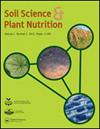Nitrous oxide and carbon dioxide emissions from two types of soil amended with manure compost at different ammonium nitrogen rates
IF 1.8
4区 农林科学
Q3 ENVIRONMENTAL SCIENCES
引用次数: 2
Abstract
ABSTRACT Ammonium nitrogen (NH4 +-N) content in soil is a key factor affecting nitrous oxide (N2O) emissions due to its role as a primary substrate of nitrification. This study aimed at investigating the effects of different application rates of NH4 +-N on N2O and CO2 emissions from two different types of manure compost-amended soil, along with analysis of relative abundances of narG and nosZ genes under aerobic conditions. Laboratory experiments were conducted using Kochi and Ushimado soils amended with mixed compost (MC: mixture of cattle, poultry, and swine manure) or cattle manure compost (CC) at 3% (dry weight basis). In no compost- and compost-amended soils, (NH4)2SO4 was added as a solution equivalent to 160, 200, and 400 mg-N kg−1 of soil. Soil samples were aerobically incubated at 70% water-holding capacity (WHC) and 25°C. Emissions of N2O and CO2 were measured on days 0, 3, 7, 15, 21, 28, and 42. The abundances of narG and nosZ genes in Kochi (day 7) and Ushimado (day 21) soils were estimated using qPCR tests. Emissions of N2O and CO2 were higher in MC-amended soil because of higher mineral N content and lower C/N ratio of MC than those of CC, regardless of NH4 +-N rates. Emissions of N2O and CO2 were higher in compost-amended Kochi soil due to higher mineral N, total N and C, and clay contents, and possibly because of higher water-filled pore spaces than those in Ushimado soil at the same WHC. In both soils with CC and no compost, raising NH4 +-N rate from 160 to 200 increased N2O emissions due to stimulation of nitrification. In contrast, increasing NH4 +-N rate from 200 to 400 decreased N2O and CO2 emissions except for N2O emissions in MC- and CO2 emissions in CC- and no compost-amended Ushimado soil possibly due to osmotic stress on microorganisms and limited C availability. Emissions of N2O were positively related to narG gene copy numbers in Kochi soil (R 2 = 0.78) due to high N and C contents. Our study revealed that NH4 +-N rate 400 suppresses N2O and CO2 emissions from manure compost-amended soil under aerobic conditions.两种土壤在不同铵态氮浓度下的氮氧化物和二氧化碳排放
土壤中铵态氮(NH4 +-N)含量是影响氮氧化物(N2O)排放的关键因素,因为它是硝化作用的主要底物。本研究旨在研究不同施氮量对两种不同类型粪肥堆肥土壤N2O和CO2排放的影响,并分析好氧条件下narG和nosZ基因的相对丰度。室内试验采用高知县和鱼岛县土壤,用混合堆肥(MC:牛、禽、猪粪的混合物)或3%(干重基础)的牛粪堆肥(CC)进行改良。在未添加堆肥和添加堆肥的土壤中,(NH4)2SO4作为相当于160、200和400 mg-N kg - 1土壤的溶液添加。土壤样品在70%持水量(WHC)和25°C条件下进行好氧培养。在第0、3、7、15、21、28和42天测量N2O和CO2的排放量。采用qPCR方法对高知(第7天)和鱼岛岛(第21天)土壤中narG和nosZ基因的丰度进行了测定。与NH4 +-N速率无关,MC改良土壤中N2O和CO2的排放量高于CC,这是由于MC改良土壤中矿质氮含量较高,C/N比较低。高知土壤的N2O和CO2排放量较高,这可能是由于高知土壤的矿质氮、全氮和全碳以及粘土含量较高,也可能是由于高知土壤的充水孔隙空间较大。在CC和无堆肥的土壤中,由于硝化作用的刺激,NH4 +-N浓度从160提高到200,增加了N2O排放。相比之下,增加NH4 +- n浓度从200增加到400,除了MC-中的N2O排放和CC-中的CO2排放外,N2O和CO2排放都有所减少,并且堆肥后的ushima土壤中不存在N2O和CO2排放,这可能是由于微生物的渗透胁迫和C有效性有限。高知土壤氮、碳含量高,N2O排放量与narG基因拷贝数呈正相关(r2 = 0.78)。本研究表明,在好氧条件下,NH4 +-N速率400抑制了肥料堆肥土壤N2O和CO2的排放。
本文章由计算机程序翻译,如有差异,请以英文原文为准。
求助全文
约1分钟内获得全文
求助全文
来源期刊

Soil Science and Plant Nutrition
农林科学-农艺学
CiteScore
4.80
自引率
15.00%
发文量
56
审稿时长
18-36 weeks
期刊介绍:
Soil Science and Plant Nutrition is the official English journal of the Japanese Society of Soil Science and Plant Nutrition (JSSSPN), and publishes original research and reviews in soil physics, chemistry and mineralogy; soil biology; plant nutrition; soil genesis, classification and survey; soil fertility; fertilizers and soil amendments; environment; socio cultural soil science. The Journal publishes full length papers, short papers, and reviews.
 求助内容:
求助内容: 应助结果提醒方式:
应助结果提醒方式:


